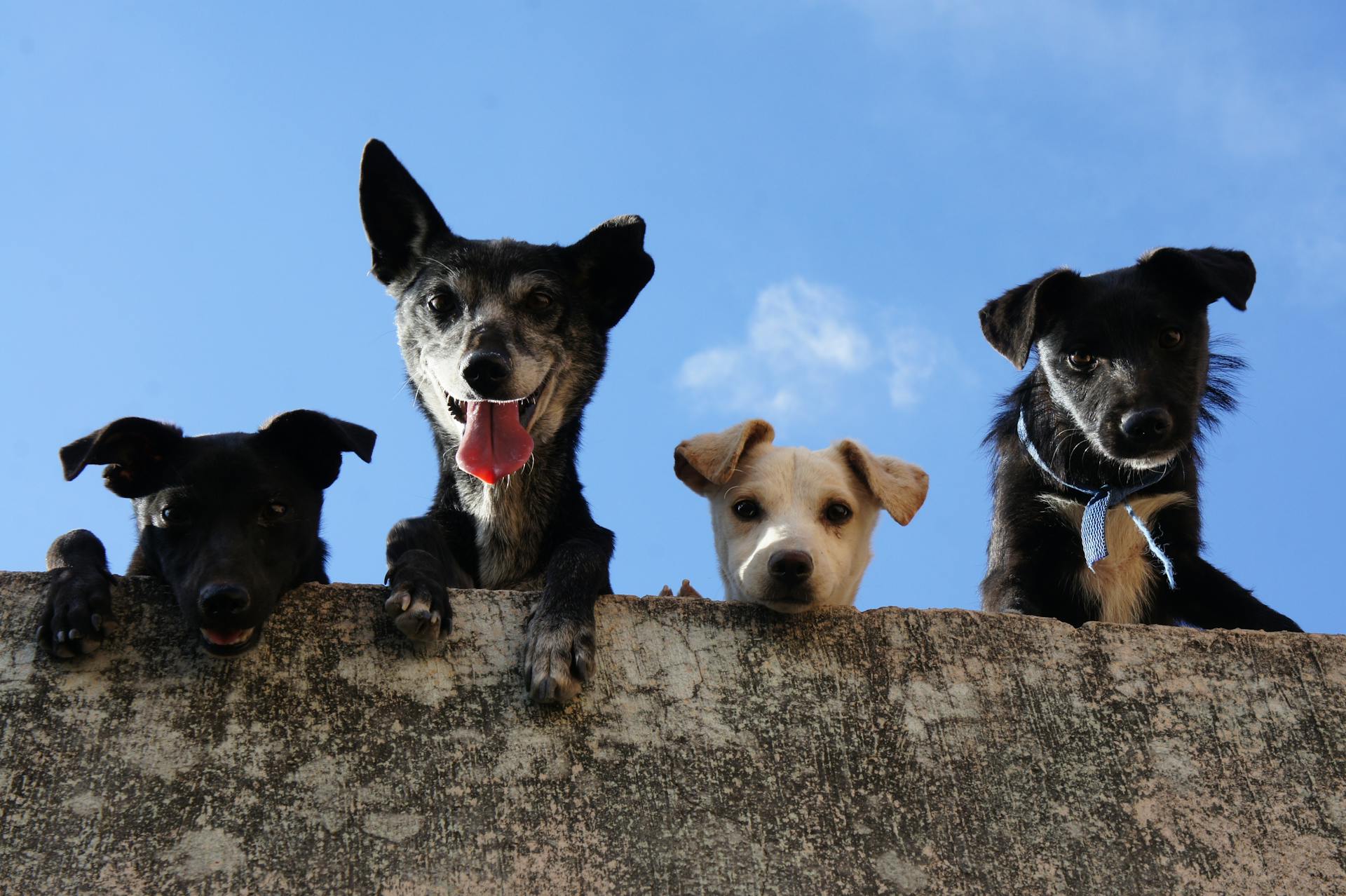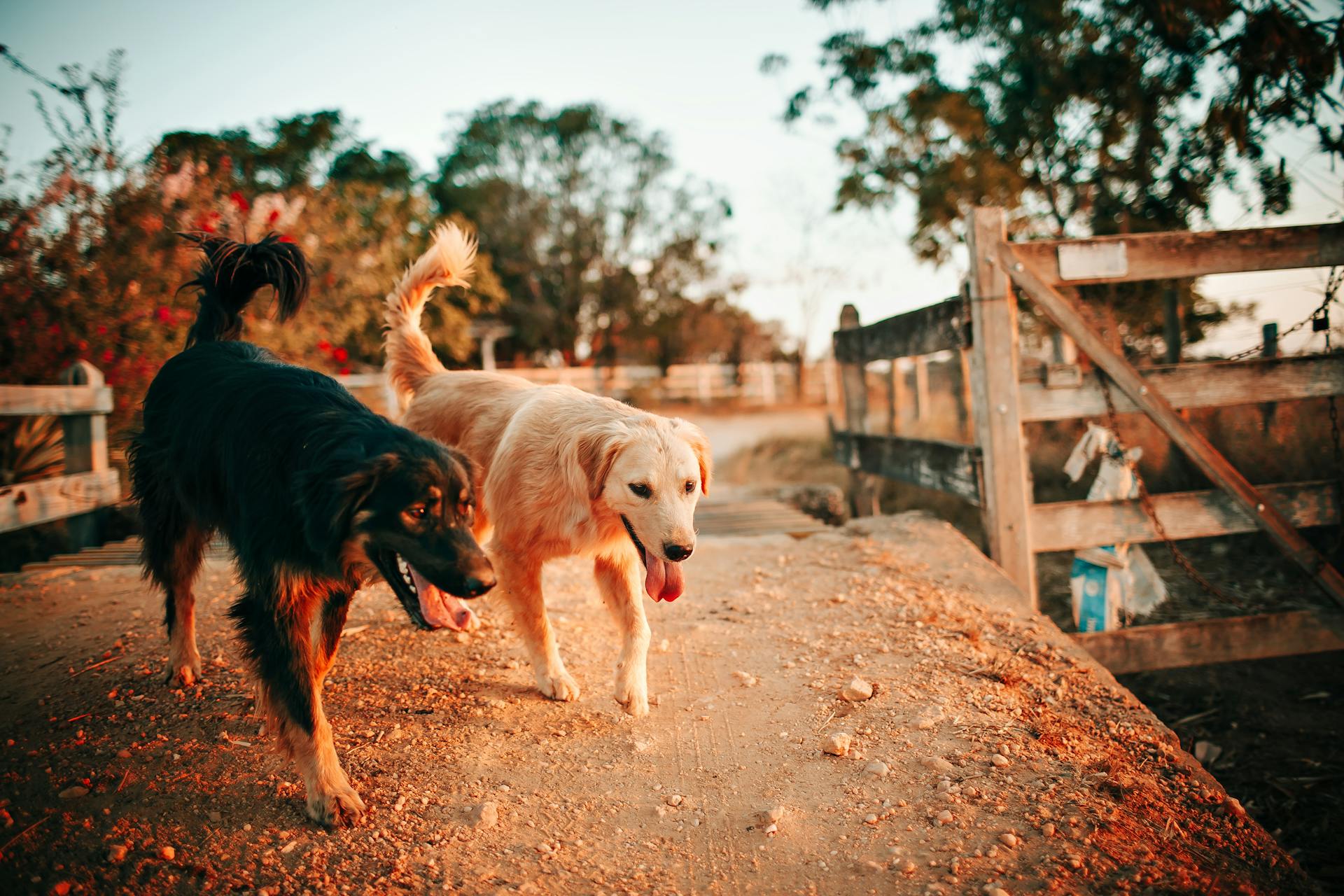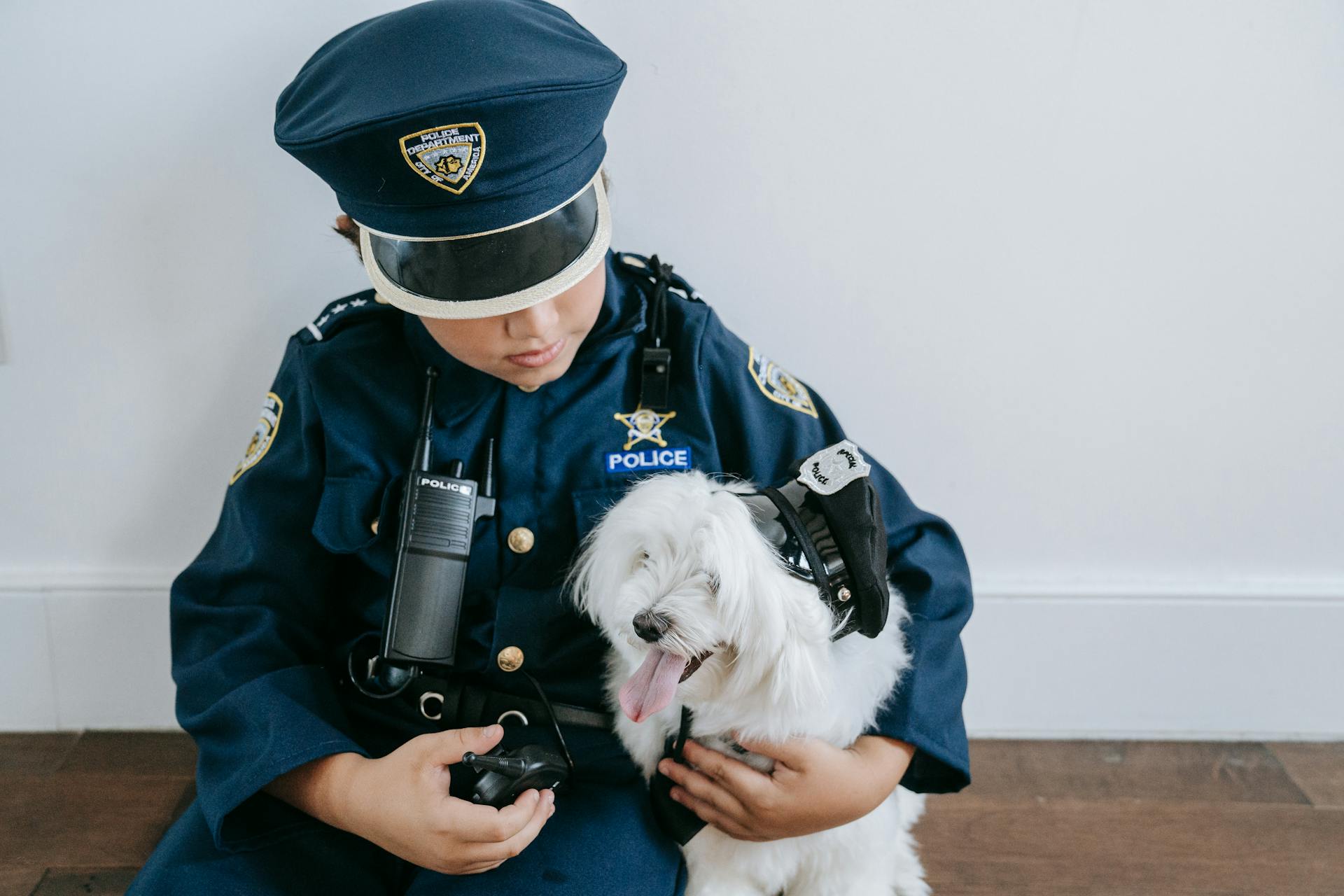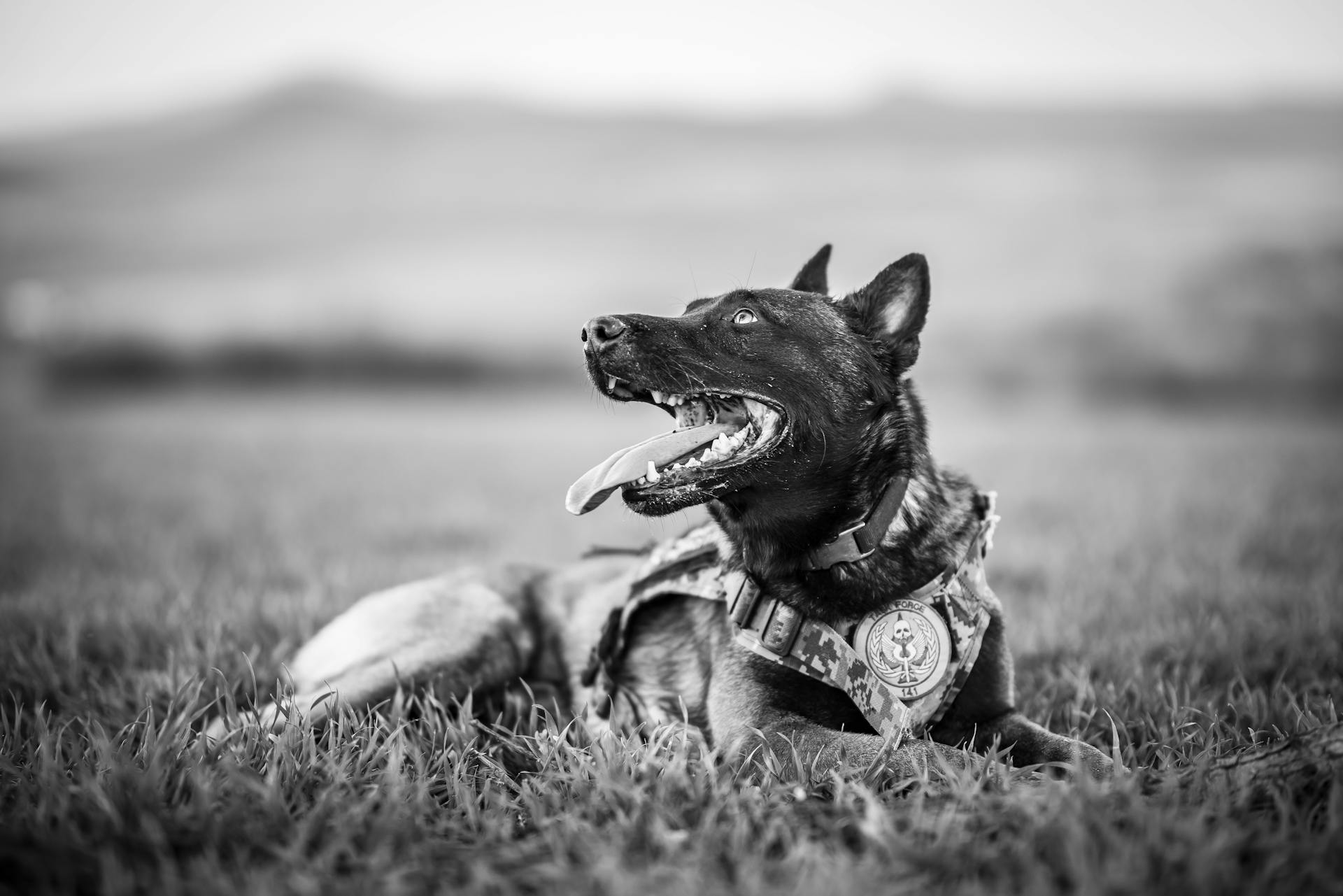
Police dogs, also known as K9s, are an essential part of law enforcement teams around the world. They play a vital role in keeping communities safe.
Police dogs are trained to detect and track suspects, as well as locate missing people and evidence. Their keen sense of smell and agility make them invaluable assets to their human counterparts.
These highly skilled animals are often trained to respond to specific commands and situations, such as narcotics detection or explosives detection.
A different take: Detection Dog
What Are Police Dogs?
Police dogs are dogs that are trained to work alongside police officers, making them a unique type of service dog. They track people down and apprehend criminals, functioning within K-9 units.
These dogs are well-trained and know how to perform several tasks that are relevant to police work.
Readers also liked: What Is a Work Dog
History and Development
Police dogs have a rich history dating back to the Middle Ages, where they were used to hunt down outlaws in villages. Wealthy landowners would contribute to the upkeep of the parish constable's bloodhounds, which were used for tracking and apprehending criminals.
For another approach, see: How Do Service Dogs Help
The first recorded use of police dogs was in St. Malo, France in the early 14th century, where they were used to guard docks and piers. By the late 14th century, bloodhounds were used in Scotland, known as "Slough dogs", which is where the word "sleuth" originated.
Police dogs were primarily used for their tracking abilities between the 12th and 20th centuries on the British Isles and European continent. The rapid urbanization of England and France in the 19th century led to an increase in lawlessness, prompting the use of private associations and night watchmen to combat crime.
One of the first attempts to use dogs in policing was made by the Commissioner of the Metropolitan Police of London, Sir Charles Warren, in 1889. However, his efforts were met with failure, as his bloodhounds were untrained and ran off during a tracking test.
The North Eastern Railway Police were among the first to use police dogs in 1908, using them to prevent theft from the docks in Hull. By 1910, railway police forces were experimenting with other breeds, such as Belgian Malinois, Labrador Retrievers, and German shepherds.
In Continental Europe, police dogs were first used on a large scale in Paris, where they were used to combat roaming gangs at night. The police department in Ghent, Belgium introduced the first organized police dog service program in 1899, which was later adopted by Austria-Hungary and Germany.
For another approach, see: Dogs Used in Warfare
Early History

Dogs have been used in law enforcement since the Middle Ages, with the first recorded use of police dogs dating back to the early 14th century in St. Malo, France.
The use of bloodhounds for hunting down outlaws was common in villages, where wealth and money was tithed for their upkeep. The parish constable's bloodhounds were a valuable asset in maintaining order.
By the late 14th century, bloodhounds were used in Scotland, known as "Slough dogs", and it's interesting to note that the word "Sleuth" (meaning detective) was derived from this.
Between the 12th and 20th centuries, police dogs on the British Isles and European continent were primarily used for their tracking abilities, a skill that's still essential in law enforcement today.
The rapid urbanization of England and France in the 19th century led to public concern regarding growing lawlessness, and private associations were formed to help combat crime.
One of the first attempts to use dogs in policing was in 1889 by the Commissioner of the Metropolitan Police of London, Sir Charles Warren, who trained two bloodhounds for tracking a serial killer.

The North Eastern Railway Police were among the first to use police dogs in 1908 to prevent theft from the docks in Hull, and by 1910, railway police forces were experimenting with other breeds such as Belgian Malinois, Labrador Retrievers, and German shepherds.
In suspect apprehension, having a loud barking dog can be helpful, and can result in suspects surrendering without delay.
Modern Era
In the modern era, police in Paris used dogs against roaming criminal gangs at night, marking the beginning of a large-scale use of dogs in law enforcement.
The first organized police dog service program was introduced in Ghent, Belgium in 1899, a pioneering effort that paved the way for other countries to follow suit.
The German police played a significant role in the development of police dog work, selecting the German Shepherd Dog as the ideal breed for the job and opening up the first dog training school in 1920 in Greenheide.
Recommended read: German Guard Dogs

In later years, many Belgian Malinois dogs were added to the German police unit, expanding the range of breeds used for police work.
The German police systematically trained their dogs in obedience to their officers, as well as tracking and attacking criminals, laying the foundation for modern police dog training methods.
Suggestion: Police German Shepherd Dogs
Popular Breeds
Police dogs come in a variety of breeds, each with their own unique abilities and strengths. Some of the most popular breeds used by law enforcement include German Shepherds, Belgian Malinois, Bloodhounds, and Labrador Retrievers.
These breeds are often chosen for their incredible working ability and desire to cooperate with their handlers. For example, German Shepherds are commonly used for their tenacity and ability to fight criminals.
Some breeds are single-purpose, meaning they have one task they perform, while others are dual-purpose, trained to perform a variety of tasks. German Shepherds, for instance, are often used for both apprehension and detection.
Here are some of the most common police dog breeds:
- German Shepherd
- Labrador Retriever
- American Pitbull Terrier
- Boxer
- Bloodhound
- Beagle
- German Short-Haired Pointer
- Belgian Shepherd
- Doberman Pinscher
- Rottweiler
These breeds are often used for specialized tasks such as tracking and detection. For example, Bloodhounds are used more for tracking rather than apprehension or detection.
Consider reading: Canine Cancer Detection
Training
Training a police dog is a lengthy process that begins with the training of the canine handler. They must complete police academy training and one to two years of patrol experience before becoming eligible to transfer to a specialty canine unit.
The handler's experience as an officer allows them to gain valuable experience in law enforcement, which is essential for training a dog to the best of its ability. Having dog knowledge and training outside of the police academy is also considered an asset.
A dog must first pass a basic obedience training course to be considered for a police department. This course teaches the dog to obey commands without hesitation, allowing the officer to have complete control over how much force the dog should use against a suspect.
Dogs used in law enforcement are trained to either be "single purpose" or "dual purpose". Single-purpose dogs are used primarily for backup, personal protection, and tracking, while dual-purpose dogs are more typical and can detect explosives or narcotics in addition to their other duties.
For another approach, see: How to Become a Search and Rescue Dog Handler
Here are the different types of police dogs and their specialized tasks:
- Apprehension and attack dogs: used to locate, apprehend, and sometimes subdue suspects.
- Detection dogs: trained to detect explosives or drugs.
- Dual purpose dog: trained in tracking, handler protection, off-leash obedience, and article, area, and building search.
- Search and rescue dogs (SAR): used to locate suspects or find missing people or objects.
Police dogs are trained to handle several tasks, including obedience training, off-leash training, evidence searching, tracking, clearing buildings, apprehension, locating deceased individuals, scent discrimination training, narcotics detection, explosive detection, open area searches, and patrol.
Specific Breeds
The Belgian Malinois is a popular police dog breed, known for its versatility and keen work ethic. They can undertake a variety of tasks and quickly learn and respond to commands.
Here are some key characteristics of popular police dog breeds:
- German Shepherd: intelligent, calm, and eager to work, with a strong sense of loyalty.
- Labrador Retriever: hardy, smart, and easy to train, with a friendly nature.
- Belgian Malinois: versatile, high-energy, and rarely tiring, with a keen work ethic.
- Bloodhound: has a sense of smell unlike any other, with the ability to follow a scent trail up to 130 miles away.
- Beagle: has a great sniffing ability, with a small size that allows them to navigate through small areas.
- Rottweiler: trainable and responds to commands, with a strong instinct to deter threats and apprehend people who break boundaries.
These breeds are highly valued for their unique skills and abilities, and are often used in a variety of roles, including search and rescue, detection, and patrol work.
German Shepherd
The German Shepherd is widely recognized as the preferred police and military dog breed. They're versatile, high-energy, and rarely tire, making them highly intelligent and easy to train.
Their intelligence and trainability allow them to pick up many commands quickly, which is essential in police work. German Shepherds were first called to service in World War I, where they performed a wide variety of tasks, including carrying messages, rescuing injured soldiers, and guarding.
In the military and bomb squads, it's not uncommon for the K-9 unit to consist of a German Shepherd. They have excellent noses that can sniff out explosives, drugs, and other problems.
German Shepherds are usually around 20 inches tall and weigh about 50 pounds, with brown, tan, and black coats. They're highly responsive to commands, and if they're apprehending someone, they'll stop biting or attacking immediately once their handler gives a command.
Here are some common tasks that German Shepherds perform:
- Guard dogs
- Tracking dogs
- Search and rescue dogs
Their calm temperament, unless provoked, makes them a popular choice for police work. German Shepherds have been used in search and rescue efforts, including the one after the 9/11 terrorist attack, where they worked tirelessly to search for survivors and provided comfort to those involved.
American Pitbull Terrier
The American Pitbull Terrier is a breed that stands out in scent work, detection, and tracking thanks to its great nose.
Many police agencies are adopting and rescuing pit bulls to bolster their K-9 units, making it a cost-effective solution.
This breed isn't as efficient in all categories as the German shepherd, but its unique strengths make it a valuable asset.
Pitbulls are entering canine units across the United States due to grant programs that encourage police agencies to adopt and rescue pit bulls.
This has become an effective way to strengthen K-9 units without breaking the bank.
Beagle
Beagles are another interesting breed used in law enforcement for their ability to pick up scents efficiently, making them great for detecting drugs, explosives, and contraband.
Their small size is also an advantage, allowing them to navigate through tight spaces and jump over luggage, which is why you'll often find them at airports and other places with tight security.
Beagles are relatively easy to train for police work and service dog activities, making them a great choice for many tasks.
Their less intimidating looks also allow them to move through busy areas relatively unnoticed, which can be beneficial when sniffing out contraband or detecting narcotics.
Curious to learn more? Check out: Great Pyrenees Guardian Dogs
Beagles are also great search and rescue dogs, thanks to their smaller size which makes them ideal for navigating smaller areas that would be difficult for humans or larger dog breeds.
Their great work ethic and ability to sniff out scents make them a popular choice for search and rescue missions, especially when rubble is involved.
Law Enforcement K9s
Law Enforcement K9s are a vital part of police work, trained to perform specialized tasks such as apprehending suspects, detecting narcotics and explosives, and searching for missing people. These dogs are often trained to be "single purpose" or "dual purpose", meaning they can perform either one specific task or multiple tasks.
Some of the most popular breeds used by law enforcement include German Shepherds, Belgian Malinois, Bloodhounds, and Labrador Retrievers. These breeds are known for their incredible working ability, desire to cooperate with their handlers, and tenacity in fighting criminals.
There are several types of police dogs, including apprehension and attack dogs, detection dogs, dual purpose dogs, and search and rescue dogs. Each type of dog is trained for specific tasks, such as detecting explosives or tracking missing people.
What Do Police Do?
Police dogs are trained to perform a few specific tasks, similar to how a service dog is trained to help someone. Their training process is lengthy and covers several areas of K-9 police work.
Most K-9 units are only trained for one specific task, but some dogs can perform multiple tasks. This means they can be specialized in different areas, such as tracking suspects or detecting narcotics.
The common tasks that police dogs are trained to perform include apprehension, detection, search and rescue, and dual purpose dogs.
On a similar theme: Search and Rescue Dogs of 911
Law Enforcement K9s
Law Enforcement K9s are highly trained dogs that work alongside police officers to keep our communities safe. They're a vital part of law enforcement teams, and their skills are impressive.
Police dogs are trained to perform specific tasks, such as apprehension, detection, search and rescue, and dual purpose work. They're often used for personal protection and tracking, and some breeds are better suited for certain tasks.
Suggestion: Working Dog
The type of dog used often depends on the kind of work the K9 will perform. For example, Belgian Malinois, German Shepherds, Golden Retrievers, Labrador Retrievers, and Bloodhounds are commonly used as search and rescue dogs.
Some police dogs are specialized to perform specific tasks, such as detection dogs, which are trained to detect explosives or drugs. Others are dual-purpose dogs, trained for both tracking and detection work.
Here are some popular breeds used by law enforcement:
- Belgian Malinois
- German Shepherd Dogs
- Bloodhounds
- Dutch Shepherds
- Labrador Retrievers
These breeds are known for their incredible working ability, desire to cooperate with their handlers, and tenacity in fighting criminals.
Frequently Asked Questions
How long do police dogs live?
Police dogs typically live between 9-15 years, but their lifespan can be shortened due to the demands and dangers of their job.
What is the most famous police dog?
Rin Tin Tin, a German shepherd, is widely considered the most famous police dog in history. This legendary canine was a trained police dog left behind by German forces in 1918.
What is the most common K-9 police dog?
The most common K-9 police dog is the German Shepherd, known for its intelligence, work ethic, and size. This breed's popularity stems from its exceptional abilities and characteristics that make it an ideal candidate for police work.
What is special about K9 dogs?
K9 dogs are exceptional police partners due to their unique combination of athletic ability and keen sense of smell, making them highly effective in various law enforcement tasks. Their high energy can be a valuable asset when channeled correctly.
What are the pros and cons of police K9?
Being a police K9 officer offers benefits like enhanced officer safety and specialized skills, but also comes with challenges like constant care and danger on the job.
Sources
- https://www.akc.org/expert-advice/lifestyle/what-do-police-dogs-do/
- https://en.wikipedia.org/wiki/Police_dog
- https://dogacademy.org/blog/police-dog-breeds/
- https://www.ppak9.org/blog/the-history-of-k9s-in-law-enforcement/
- https://www.purina.co.uk/find-a-pet/articles/dog-types/breed-guides/police-military-dogs
Featured Images: pexels.com


